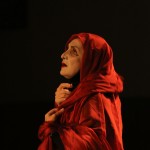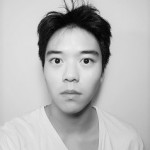“Contemporary Class Conflict”
Reviewer: Edward Eng
Performance: 16 August 2019
Lin Meng-huan is not the first writer to suggest members of the underclass are treated like primal animals. But his portrayal of the subhuman treatment of the down-and-out using imagery from homelessness and East Asian hikikomori (adults who choose to live in complete isolation from the outside world) is very intriguing. A Dog’s House teeters on extremity, though I sometimes wished the forces in it worked more to serve the emotional narrative.
The play is set in a dumpy apartment. Between empty crisp packets and laundry, a pair of siblings is bound by an ambiguous relationship. Brother is an unemployed man who obsesses about going outside and living life, but instead watches TV all day long. Sister is slightly more functional: she goes to school and gets takeaway for Brother.
Their mother, who somehow does not live with them, is always present offstage. Several times a week, she brings Sister out for ‘afternoon tea’, which appears perfectly innocuous at first and draws Brother’s jealousy. Sister becomes uncomfortable with this arrangement. In Pinteresque rhythm, ‘afternoon tea’ turns increasingly odd – on one occasion Sister dresses in a Qing dynasty costume.
And as if the pressure is not piled on heavily enough, we are suddenly introduced to Older Brother, who has been isolating himself in his room all this while. Feral screams and the sounds of late-night sawing destabilise the two-sibling relationship.
I read the three siblings’ levels of feral-ness as an allegory of today’s class conflict. Each sub-class has a complex relationship with the one just above it. Three-bedroomers disparage four-bedroomers for being self-indulgent. They aspire to climb one rung up and are terrified of slipping one down. They are unable to recognise anyone below them as anything but animalistic: the uncivilised. The siblings in A Dog’s House even wear dog collars.
Next to them, Mother is an authority figure, her role anchored by questions her presence raises: why, for instance, has she put her three children here?
But the nagging question of where Father is is one force too many. He is mentioned sketchily, only three-quarters through the play. The lightness of his existence in the siblings’ minds imbues the mood with an unfinished, unexplained yearning, which seems too sudden a leap from the fearful tension that has been building all this while.
Then the play really topples over. The physical violence that suddenly erupts between the siblings is particularly sexual. There is little build-up between the first and second instance of it, which makes it difficult to make sense of either because the rest of the play is bound by a well-considered emotional logic.
I suspect the point A Dog’s House tries to make is something along the lines of how violence erupts when the wants and desires of the oppressed are repressed. But mining the theatrical form to excavate an understanding of how that eruption comes requires a defter pen, and certainly sharper direction. It needs to ensure the analogy between physical need and desire is precise to create meaning.
Do you have an opinion or comment about this post? Email us at info@centre42.sg.
ABOUT THE PRODUCTION
A DOG’S HOUSE by M.O.V.E Theatre
15- 18 August 2019
Part of M1 Patch Theatre Festival 2019
Practice Space
ABOUT THE REVIEWER
Edward is a playwright whose work has been performed locally as well as in China and across the UK. He read Philosophy, Politics and Economics at university and is interested in using the lenses he has picked up there to celebrate the nooks and crannies of Singapore theatre.





